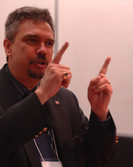teaching critical thinking
Select an item by clicking its checkbox

Teach Like the Mind Learns: Instruct So Students Learn to Think, Read, and Write Critically
Date Reviewed: June 23, 2017
This volume is the most recent of a triumvirate of interrelated works Maiorana has recently published. Teach Like the Mind Learns builds off Fixing Instruction: Resolving Major Issues with a Core Body of Critical Knowledge for Critical Instruction (2015) and Preparation for Critical Instruction: How to Explain Subject Matter While Teaching All Learners to Think, Read, and Write Critically (2016). Maiorana’s larger project is an ambitious one. He takes aim, with broad brushstrokes, at rote-learning styles of instruction, a specter he calls “serialism” and describes as the “teaching profession’s weak default instructional strategy” (4). He contends that this pervasive style inhibits “our innate ability to think critically” (155).
As an antidote, Maiorana offers his own unique instructional framework. He argues that subject matter is universal and critical in nature across disciplines. He also argues that one can teach how the mind learns, and as a result, promote teaching that gets students to write, speak, and observe critically. One can do this by utilizing “mind grammar,” which he defines as the “innate, systematic, and patterned way that the human mind encounters the world and all its subject matter” (6), At the core of mind grammar instructional techniques are what he calls “subject matter displays.” Much of the practical approach involves formal concept mapping and displaying the explanation of a certain term or concept with related activities. The book unfolds in two main parts: part one provides an overview of Maiorana’s theoretical basis for critical instruction, and part two offers numerous examples of activities and instruction sets using this framework.
Teach Like the Mind Learns is a tough nut to crack. This is largely because it is a closed intellectual loop. The only other instructional literature Maiorana cites in footnotes and references in passing are his own two earlier works on the topic. He even instructs the reader to purchase his previous books so one can better follow the self-referential citations that abound in each chapter. The first-time reader must further master Maiorana’a distinctive vocabulary, from mind grammar to “Itechniques” and “Imethods.”
Consequently, the learning curve for reading Teach Like the Mind Learns is steep. It is largely predicated on the assumption that the reader has read and embraced Maiorana\'s earlier works. There are some helpful insights throughout, including the example teaching exercises that make up the second half of the book. But as Maiorana’s approach avoids engaging with any other instructional literature beyond his own, it is ultimately not clear how one might use this approach in combination with other pedagogical styles and resources to improve classroom instruction. Further, he suggests a remarkable universality to his framework, regardless of specific context – from elementary through college-level instruction – a bold one-size-fits-all approach.
In a world of opportunity costs, limited time, and limited energy, someone looking to explore “how the mind learns” would be much better off diving into the established science of learning literature. There are numerous accessible works on its foundations and praxis, and several that are specifically about improving instruction at the college level, such as James Lang’s Small Teaching (San Francisco: Jossey-Bass, 2016) and Donelson Forsyth’s College Teaching (Washington, D.C.: American Psychological Association, 2016).
On election night last year when Donald Trump won the presidential election, I was traveling in Greece visiting the historical and religious sites. Several days before the election, I visited the Acropolis and climbed up Mars Hill where Paul delivered his sermon to the Athenians (Acts 17:22-31). The fact that ...
I am convinced that all eurocentric philosophical thought and movements – yes all – are oppressive to those who come from colonized spaces. When I contemplate every philosophical contribution made by the so-called Age of Enlightenment, it becomes obvious that the French Revolution’s battle cry for Liberté, Egalité, Fraternité was never ...
As an anthropologist of religion, I have advocated that the skills one develops in an ethnographic setting are necessarily translated to the classroom. I’m a proponent of creating a space for students to serve as experts and to speak to their own experiences—especially when addressing contemporary political movements ...
This is the third and penultimate blog in a series of posts in which I have sought to meditate on the question of how one might present theoretical/conceptual arguments to students in an introductory course on Islam in a manner that does not burden them with theory talk. To ...



